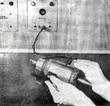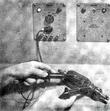Checking Armature
Armature faults are in many cases not externally visible. Checking
should include tracing of open circuits as well as winding and earth
shorts.
Testing

| 1. Open circuits are generally recognizable on the commutator by burn
spots between two segments. They can also be measured with a sensitive
resistance measuring bridge.
2. Winding short circuits between windings of an armature coil can be
traced on an armature test meter. The armature is rotated between two
test probes, a magic eye then indicates the winding short
circuit. Another instrument consists of an AC magnet with two jaws
which take the armature. Here the armature is slowly rotated about its
axis a thin piece of steel sheet being placed on top of the
armature. If there is a short circuit in the winding the sheet of
metal will begin to vibrate violently at 2 or more places around the
periphery of the armature. With another instrument the armature is
rotated in the same way over the jaws of an AC magnet while the tester
probes the commutator core with a probe.
The alternating current produced in the coil of the probe as a result
of induction from a winding short circuit can be heard in the test
head phones as a humming noise.
|

| 3. A short to earth will occur if the armature core is shorted to the
winding or if carbon dust ha s penetrated into the winding. The test
should be carried out with a test lamp of 40 V between armature iron
and commutator. The test lamp should not light up.
4. If the commutator is oval or is rough as a result of burn spots or
grooves have occurred as a result of running in of the carbon brushes
it must be skimmed and polished which is essential to obtain a
satisfactory surface.
The insulators between the segments should be reworked with a
commutator saw until they are recessed back about 0.3-0.5 mm from the
contact face of the commutator.
|
Last modified: Sat, 15 Jan 2005
Links
|





